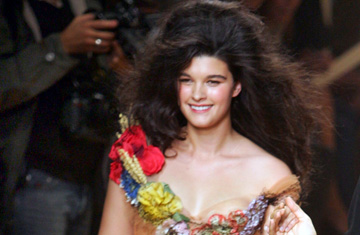
French fashion designer Jean Paul Gaultier takes to the catwalk with model Crystal Renn
Six years ago, Crystal Renn was an unknown size-0 model who moved to New York City from Clinton, Miss., to make it big. She struggled with her weight for years, however, and finally made the bold decision to switch to plus-size modeling. Now a healthy 165 lb., she is the highest-paid plus-size model in the world, having graced the covers of American Vogue and Harper's Bazaar and appeared in Dolce & Gabbana ads. The 23-year-old talks with TIME about her new book, Hungry, her size-0 modeling days and walking the runway for Jean Paul Gaultier.
How did you get into modeling?
When I was 14 years old, my mother put me in an etiquette beauty school. One
day a scout came up to me and said, "Oh, my gosh, you're going to be the next
supermodel." I didn't even know what that meant. He pulled out a picture of
Gisele and said, "This is who you can be." But he said I had to lose nine
inches off my hips. That was the beginning.
You got down to 95 lb. on your 5 ft. 9 in. frame. What was your typical
day like when you were a size-0 model?
Before I began modeling, I prepared for two years, and in that time I
developed an eating disorder. My day would involve waking up and steaming
vegetables. Then I would go to 10 castings, followed by a trip to the gym for
three to four hours and sometimes even up to eight hours. I would eat
lettuce and vegetables all day long, but I would think about food all the
time.
When you look at a picture of yourself at that weight, what do you see?
Another person. It was very clear that I hated my life. During that time, I
felt extremely detached from my body. I didn't feel like me or feel anything
at all. The only way to survive was through detachment. I would wake up
sometimes feeling like I had the flu times 10, and I knew I would have to go
to the gym for eight hours.
What was it like to start eating again?
When I had the eating disorder, I never lost my love for food. I just told
myself that if I wanted to be a model, I would have to stop [doing] one of
my favorite things. I remember having my epiphany moment and making the
decision to eat again. It was pretty amazing. My first meal was what many
would regard as very healthy: a salad with salmon, walnuts and olive oil. At
the time, I feared that I would gain 100 lb. with one bite. It didn't
happen, and I felt superrelieved. I knew I was on the right path.
Do you still worry about your weight?
When it comes to food, I've been through such a deep, dark place with my
body that I associate dieting and hating my body with extreme unhealth. I
was losing my hair, I had no energy, and I was extremely depressed. I don't
really watch my weight at all now. I do make sure that I eat as healthy as I
can for energy purposes, but I no longer restrict my calorie intake to feel
better about myself.
It took a lot of courage to write about this. How did the fashion industry
react to your book?
Surprisingly, I've found the industry to be extremely supportive. When I
first moved over to plus-size modeling and I had this new body, I worked
with an editor who knew me when I had the eating disorder. She said, "What
happened to you? You look so much better now!" At that moment, I made a
decision to tell the truth. I felt relief in telling my [story]. I think
people in the industry have become more receptive to looking at different
body types because of my book and my [decision to] speak out.
What was it like to walk out on the runway and close the Paris show for Jean
Paul Gaultier in 2005?
Walking for Jean Paul Gaultier was magical. I had no idea I was ending the
show in the first place until I was about to walk out on the runway. This
had been a dream of mine for so long, so it was definitely a moment. I never
felt so accepted in my life, and I now know that change is possible after all
in this industry.
What do you hope other women will gain from this book?
Women have come so far in the past 100 years. But what holds them back is
lack of confidence and self-hatred. Those two things can affect every part
of your life. I was at the lowest level you can be. It was only when I
accepted myself that I managed to achieve [my goals] in life and work.
Through this book, I want women to know that people in the [fashion] industry can relate to them too. Women struggle everywhere with their
weight and their bodies, and no one talks about it. I wanted to speak for the
unspoken.
